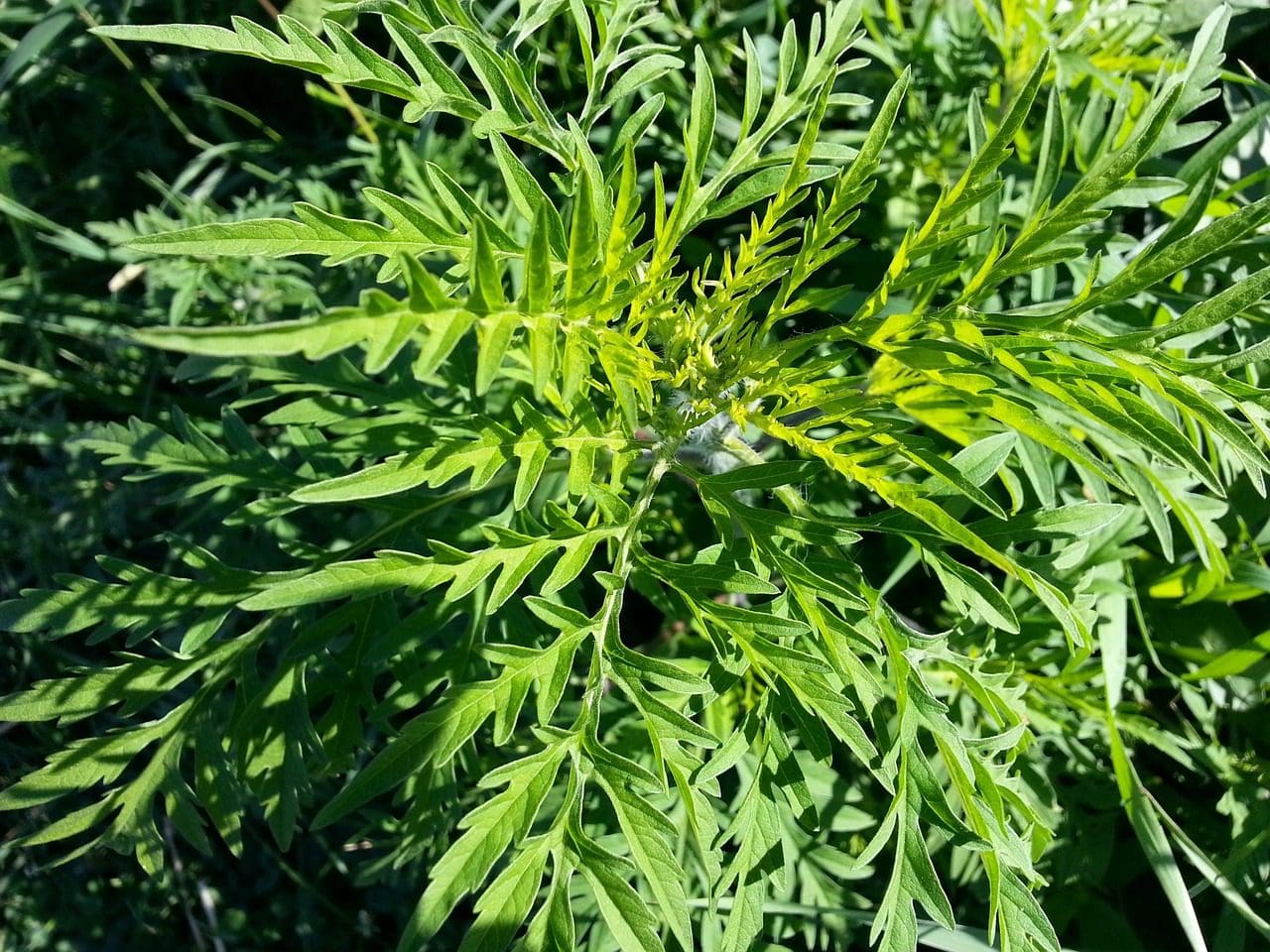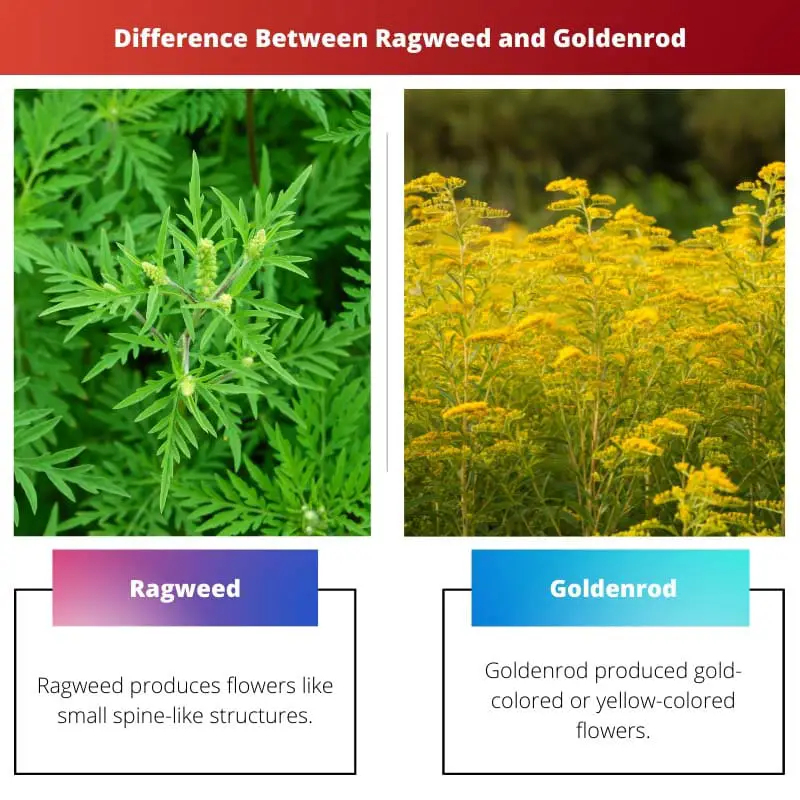Ragweed that is present in the ecosystem produces a lot of pollen. This pollen tends to spread in the air. It also causes allergy, and hence it is an allergen to those who are sensitive to pollen in the air.
Ragweed belongs to the kingdom of plants. Goldenrod produces flowers, and it comes under the family of sunflowers.
Key Takeaways
- Ragweed is a weed that causes seasonal allergies in humans, whereas goldenrod is a flowering plant that does not cause allergies.
- Ragweed has small green flowers and produces a large amount of pollen, while goldenrod has bright yellow flowers and produces sticky pollen from insects rather than the wind.
- Ragweed is found in rural areas, while goldenrod is commonly found in meadows and along roadsides.
Ragweed vs Goldenrod
Ragweed is a type of weed that belongs to the Ambrosia family. It grows in fields, along roadsides, and in other disturbed areas and is known for producing a large amount of pollen. Goldenrod is a type of flowering plant that belongs to the Aster family. It is commonly found in meadows, along roadsides, and in other open areas and is known for its bright yellow flowers.

Ragweed produces flowers, and they belong to the tropical region. They contain distinct small-sized flowers; they resemble a small thorn-sized or spike-shaped structure.
They have pollens that are allergic to some people who are sensitive. They cause significant disturbances and intolerance in those who are sensitive, leading to a food-based allergy in intolerants.
Goldenrod contains flowers that are golden in color. As the name suggests, the color of the flowers produced by Goldenrod is distinctly bright yellowish in color.
It is found in various regions across the globe. It contains a lot of anti-inflammatory properties that are very useful for medicinal purposes. It is great for aiding people with nephrological issues.
Comparison Table
| Parameters of Comparison | Ragweed | Goldenrod |
|---|---|---|
| Flowers produced | Ragweed produces flowers like small spine-like structures. | Goldenrod produced gold-colored or yellow-colored flowers. |
| Mode of pollination | The mode of pollination is through its own self or via air. | Goldenrod is pollinated with the help of insects. |
| Places of growth | They are found in Canada and North America. | They are found in the eastern part of North America. |
| Applications | They are used as an antihemorrhagic agent and applied in areas of bleeding. | They are used as anti-inflammatory agents. |
| Habitat | They belong to the habitat of fields and widespread lands. | They belong to the habitat of damp or drylands. |
What is Ragweed?
Ragweed comes under the wide family of Asteraceae. They can be found in North America. They are a widespread variant and can be easily spotted. Ragweed is an allergy-causing agent.
The widespread allergen causes infection, including the allergic reactions classified by a cluster of allergic reactions in the oral system.
This allergic reaction is characterized by irritation in the oral region when there is a consumption of the provided food products, including bean varieties, celery, and fruits such as kiwi and melon.
The allergy stimulates an immune response as a counter-effect to the allergic reaction caused by the ragweed.
Ragweed is being eradicated by various constructive protocols across different countries. Ragweed infection causes allergic reactions, including food allergy and cold-like symptoms as side effects.
This weed produces a lot of pollen as a part of its shedding stage. This pollen causes a chronic illness in those areas where people have intolerance towards pollen grains.
A toxic respiratory situation is caused by ragweed pollen. Ragweed has a higher potential to cause allergic reactions when ragweed allergy hits through the seasons.
Ragweed is the least common in urban areas. While consumption of a few veggies and fruits, including cucumber, banana, cantaloupe, and zucchini, causes allergic reactions.

What is Goldenrod?
Goldenrod contains yellow fluffy small-sized flowers. Goldenrod contains wide stream uses, and most people aren’t aware of it. These plants are grown in grasslands along with other vegetables.
There are more variants in the goldenrod. These different variants grew in various seasons depending on their seasonal requirements.
These goldenrod varieties have bright-colored flowers that contain nectar for those insects that helps in pollination. They are used while planting crop varieties.
These goldenrods, while attracting insects, help in retaining them in the fields, which will, in turn, help in the pollination of various other crops grown in fields.
Goldenrod, with its beautiful petals in flower, has been producing a lot of nectar for all the insects that require it. It is an average of five feet tall when it grows mature. It requires sun exposure.
The required soil pH for goldenrod growth is an average of neutral pH. The pH ranges somewhere from 6 to 7.5. The area of growth is predominant in the North American region.
The variants are more across the globe for goldenrods. All variants grow a few feet tall. There are used in various applications. A few of them include dye preparation as well as in medicine.
These flowers are bunched on top of the stem. There is a lot of medicinal importance to the goldenrod. They are used to treat arthritis and other joint-based illnesses. It is also used in the treatment of nephrological sickness.

Main Differences Between Ragweed and Goldenrod
- The main difference between Ragweed and Goldenrod is that they have different applications and medicinal values.
- Ragweed has smaller flowers, whereas goldenrods contain bigger flowers that are yellow in color.
- The mode of pollination differs with both ragweed and goldenrod as both of them rely on different sources for pollination.
- Both crops require different soil or habitat to grow. Ragweed is similar to those woodland variants available. In contrast, goldenrods are more of a perennial variant.
- Ragweed can be spotted in prairies, whereas the goldenrod can be found in the Northern American region.

- https://pubmed.ncbi.nlm.nih.gov/29788026/
- https://www.jacionline.org/article/S0091-6749(07)03074-6/fulltext

The article delivers an in-depth analysis of the nature and features of ragweed and goldenrod, highlighting their differences in terms of plant structure, areas of growth, and health-related implications.
The article offers an insightful comparison of ragweed and goldenrod, emphasizing their botanical distinctions, habitat preferences, and applications. A comprehensive guide for understanding these plants.
I concur with your assessment. The article effectively communicates the differences between ragweed and goldenrod, enhancing readers’ knowledge about these plants.
Absolutely, the content elaborates on the unique features and uses of ragweed and goldenrod, providing a detailed analysis of their ecological roles and health-related aspects.
The detailed explanation about ragweed and goldenrod is enlightening. It emphasizes their differences in structure, habitat, and application, shedding light on their respective properties and usage.
I completely agree with your assessment. The article showcases the uniqueness of these plants, explaining the relevance of their properties, allergens, and diverse uses with clarity and depth.
The content offers a thorough understanding of the differences between ragweed and goldenrod, considering their physical attributes, growth patterns, and uses. It is quite informative and useful for anyone interested in botany.
Absolutely, the comparison table provides a concise yet comprehensive summary of the contrasting features of ragweed and goldenrod, making it easier to recognize and differentiate them in the natural setting.
Yes, the article discusses the key takeaways of the two plants, ranging from their appearance, mode of pollination, to their different applications. The detailed comparisons make it a valuable resource for readers.
The article effectively explains the distinct characteristic features and habitat differences of ragweed and goldenrod, providing a deeper understanding of their biological nature.
The article offers a detailed comparison of ragweed and goldenrod, elucidating their differences in terms of flowering, pollination, applications, and natural habitat. It’s highly informative.
Indeed, the article provides an insightful study of the two plants, exploring their unique attributes, uses, and ecosystem preferences with great clarity.
This article provides a detailed comparison between ragweed and golden rod, explaining the structure, properties, uses, and allergenic properties of both plants. It also helps understand the habitat, range, and applications of each plant. This is a very informative article.
I agree, this article provides great insight into the nature of ragweed and goldenrod, discussing their biological and geographical properties, along with the potential impact on human health. It’s a comprehensive and detailed comparison.
The article offers a comprehensive overview of ragweed and goldenrod, covering their allergenic properties, botanical features, and uses. It’s a valuable source of information on these plants.
Indeed, the article presents a detailed comparison of ragweed and goldenrod, elaborating on their distinct features and growth patterns. It’s an informative guide for understanding these plants.
I share your viewpoint. The article effectively communicates the differences between ragweed and goldenrod, providing a comprehensive understanding of their characteristics and implications.
The article provides a thorough understanding of the distinct characteristics of ragweed and goldenrod, offering valuable insights into their botanical properties and applications.
I share your viewpoint. The article conveys the differences between ragweed and goldenrod comprehensively, enhancing the readers’ knowledge about these plants.
I completely agree with your observation. The article presents a detailed comparison of the two plants, highlighting their diverse features and ecological significance effectively.
This article meticulously explains the attributes and distinctions between ragweed and goldenrod, offering valuable insights into their appearance, properties, and biological significance.
I concur with your assessment. The article’s detailed analysis of ragweed and goldenrod facilitates a comprehensive understanding of their features and implications.
Absolutely, the content provides an extensive study of the two plants, discussing their habitat, uses, and allergenic characteristics in a detailed manner.